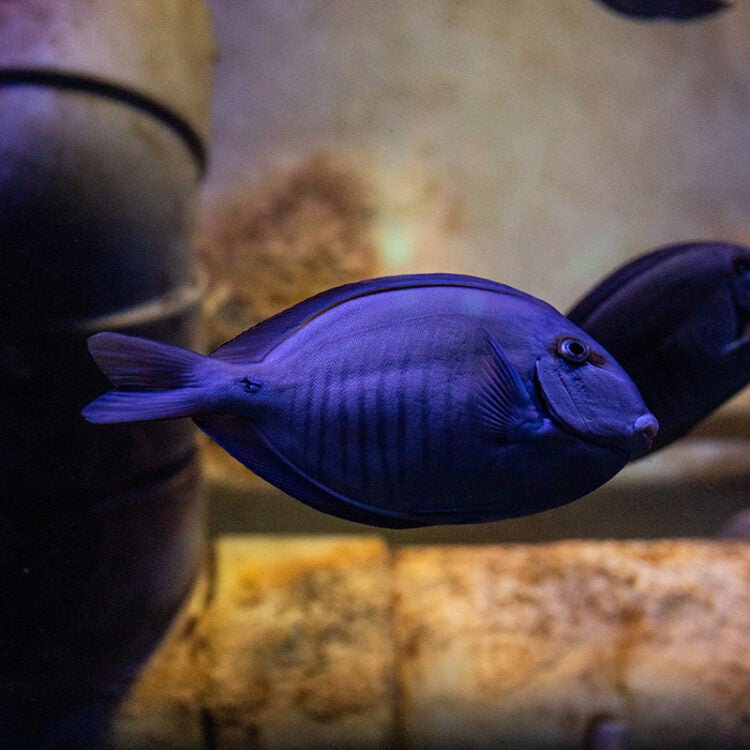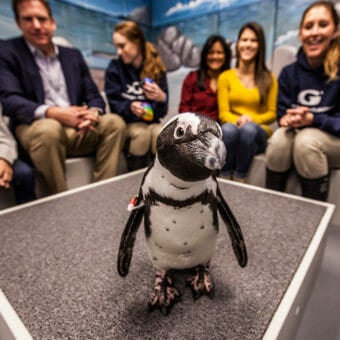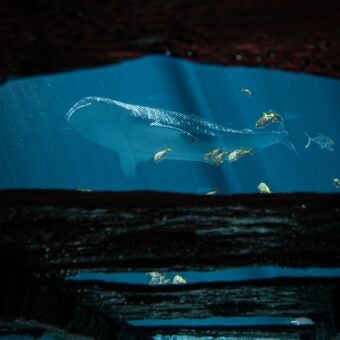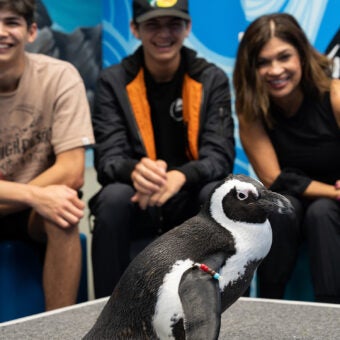-
Size
10 inches (25 cm) -
Diet
Benthic algae and zooplankton -
Range
Western Atlantic -
Habitat
Shallow reefs and rocky areas
Physical Characteristics
- This species grows to 15 inches (38 cm), although it is most commonly about 10 inches (25 cm) in length.
- The doctorfish is a type of surgeonfish, a group that is named for the sharp, blade-like spine on both sides of the caudal peduncle (the base of the tail).
- All surgeonfish have a compressed body with the eye high on the head and a single un-notched dorsal fin.
- The doctorfish is grey to brown in color with approximately ten faint, well-spaced vertical dark bars on its sides.
- Displays a bright blue edge around its spine.
Animal Fact
The doctorfish has a gizzard-like organ in the intestines that contains sand and aids in grinding up food prior to digestion.
Diet / Feeding
- Consumes benthic algae and zooplankton.
- Serves an important role on the reef in preventing fast-growing algae from over-growing hard coral.
- A gizzard-like organ in the intestines contains sand particles, which aid in grinding up food prior to digestion.
Range / Habitat
- Occurs in the Western Atlantic from Massachusetts, Bermuda, the northern Gulf of Mexico and the West Indies south to Brazil. In the Eastern Atlantic, it is reported from Ascension and St. Helena Islands and Senegal, West Africa.
- This species prefers shallow reefs and rocky areas. It occurs in loose aggregations.
Reproduction & Growth
- Spawning takes place during the lunar cycle when there are the strongest currents and largest tidal ranges.
- The male and female pair off and move to the surface and release their gametes into the open water.
- The planktonic larval stages last about 10 weeks, drifting with the current. The juveniles that develop from the larvae settle back onto reefs to continue the life cycle.
- The doctorfish juvenile resembles that of the ocean surgeonfish, though the young doctorfish are more commonly found closer to shore.
Conservation Status
- “Least Concern” on the IUCN Red List.
Additional Information
- The doctorfish is one of many species of surgeonfish. In addition to differences in overall body coloration, individual species can be distinguished by the color of the tail spine. The ocean surgeonfish (A. bahianus) has a white area around the spine while the blue tang (A. coeruleus) has a yellow-colored spine. The doctorfish can be distinguished by its bright blue-edged spine.
- The spine is typically held in a fleshy body groove and is used to defend territory, ward off predators and display social dominance.
- Only active by day, the surgeonfish hides and sleeps in reef crevices at night.
- Doctorfish swims singly or in small aggregations, sometimes schooling with other species of surgeonfish.
- Pectoral (side) fins are used for swimming, aided by the tail when speed is required.
- Juvenile doctorfish have been observed at cleaning stations, with other fish species, eating parasites and grazing algae from green turtles’ flippers, head and carapace.
- Adult surgeonfish will also attend cleaning stations to be groomed by gobies and cleaner wrasses. Surgeonfish can change color from dark to pale in order to highlight the problem areas where parasites are damaging their skin. However, if a shrimp comes to the cleaning station to service a surgeonfish, the fish does not pale in color because the shrimp works to clean the fish of parasites by means of touch, and not sight, like the goby.
- Algae growth increases in areas where hard corals have died due to natural causes or pollution. This new ocean habitat is an ideal area for algae feeders like surgeonfish. Surgeonfishes that travel in schools graze in these areas and the algal outbreak is soon contained, thereby allowing some recovery of coral.
Sources
- www.fishbase.org
- Surgeonfishes, Rabbitfishes and Their Relatives. Kuiter, R. H. and Debelius, H., pgs. 3-8, 65-68.
- Surgeonfishes of Hawaii and the World. Randall, J. E., pgs. 1-20.
- Reef Fish. Thresher, R. E., pgs. 144, 150.





